Abstract
As an integral part of the EU’s Green Deal, the purpose of the bioeconomy is to ensure an effective transition to meet people’s needs based on renewable resources while maintaining economic growth. This study undertakes the modeling of bioresource value scenarios in the agricultural sector and proposes a methodology to evaluate the possibilities of reaching a higher added value of bioresource products. The main objective of the study is the adaptation of the market allocation–energy flow optimization model system (TIMES) for analysis of high-value-added product production capacities in the livestock sector to reach an increase in added value for 2030 with the introduction of new technologies. The developed model is tested in a case study of the animal husbandry sector in Latvia. The results show which pathways are economically feasible to achieve value-added targets set for 2030. Although not all of the available resources are used due to local market limitations, there is significant potential for the use of animal husbandry resource waste, and it is possible to achieve about 62% higher cumulative added value from 2023 to 2030 with the production of new products (protein powder, wool pellets, and gelatin) in comparison with the base scenario.
1. Introduction
Rapid population and economic growth increases the consumption of a large array of natural resources while simultaneously placing pressure on climate, ecosystems, and biodiversity [,]. In terms of this pressure, the bioeconomy is an essential part of sustainable development in line with the ecological needs and limits of the planet—not only can a bioeconomy approach reduce organic waste and emissions, but it can also increase food safety, reduce concerns of biomass scarcity, etc. []. The development of the bioeconomy also contributes to the implementation of the targets set in the European Green Deal, which foresees the use of renewable resources from agriculture and the utilization of residue and waste to produce food, feed, materials, and energy []. The bioeconomy strategy currently consists of two relevant stages: a medium-term scenario target until 2030 and a long-term target until 2050 []. It is predicted that a sustainable bioeconomy will thrive via developing a circular economy by not only introducing sustainable production but also using biowaste as a raw material for new products with the highest possible added value in production, implementing a systemic approach that reduces food waste and provides safe and nutritious food, changing the consumer’s mindset towards more sustainable consumption patterns, creating new innovative uses of biological resources, and implementing a bioeconomy with a sound industrial base that reduces dependence on fossil resources [].
Agriculture is one of the sectors that yields a great volume of biomass and biological waste for higher-added-value production, which could limit climate change, strengthen European competitiveness, reduce both energy and non-renewable resource dependence, and ensure food safety [,]. However, more determined legislation incentives, operational rules, involvement of stakeholders, and research and innovations at the EU (European Union) and national level are required []. The agricultural sector in Latvia is the third most significant sector contributing to GHG emissions, right after the energy and transport sectors, and in 2018, it contributed to 22.3% of the total national emissions []. Agriculture is in the most direct contact with natural resources, and this sector is directly and/or indirectly related to all sectors []. Since many resources used in agriculture are exhaustible, it is essential to find methods that ensure their efficient management, sustainability, and availability in the future []. Agriculture is an industry subject to technological processes, the application of which directly affects the production of a competitive product [,]. In addition, the sustainable development of agriculture can also impact other sectors where it is necessary to reduce GHG emissions [,].
For further development of the bioeconomy, it is relevant to expand biorefineries, as this is the multifunctional system that turns biomass into beneficial products []. Biorefineries depend on the amount of feedstock produced that can be used to produce higher-added-value by-products []. The research on scenarios for the development of biorefining and valorization of bioresources is helpful in bioeconomy policy planning. It is essential to evaluate the divergent aspects linked to the implementation of biorefineries prior to setting national bioeconomy goals for specific added value thresholds. Thus, the main aim of the research is to evaluate the contribution of animal husbandry bioresources to the development of bioeconomy on the national scale. Although agriculture plays a huge role in any economy, especially because it produces essential goods and demand is constantly growing, the growth of the agricultural sector lags slightly behind the growth of other sectors, as its potential is underutilized—currently, it is very important to increase not only productivity but also the added value of agricultural products. Moreover, this is very characteristic of agriculture not only in Latvia but throughout Europe []. Currently, it is also important to pay attention to the livestock sector of agriculture in Latvia because of its lower profitability compared to plant cultivation. Thus, the aim of this study is to discover the least costly solution to achieve 30% added value in the animal husbandry sector of Latvia in 2030 with the help of new products with higher added value, which are produced from current product residuals. The added value goal of 30% by 2030 (compared to the value in 2015) was selected as a very high and challenging target within the research project “Bioresource Value Model” funded by Latvia’s state budget Fundamental and Applied Research Project. Such a high target would reveal the pathways for a rapid increase in the value of the bioeconomy and bioresources. The novelty of the developed model for the purpose of the study lies within the fact that, to date, there is no empirical evaluation tool that allows researchers to study the impact of new technologies on the national bioeconomy. Moreover, there is no clear economically viable pathway set for the valorization of specific agriculture residual products.
Empirical tools for the multiplex analysis of systems and the analysis of different development scenarios are applicable to shaping policy strategies. A tool that would make it possible to consider various aspects in the assessment regarding the rivalry for biomass to simultaneously meet the requirement for products in various sectors, for instance, energy, food, and medicine [], is a significant advantage in the planning of any national policy. There is a variety of choices among existing tools for the survey of the bioeconomy, such as the energy–environment–economy global macro-economic (E3ME) model [,] and computable general equilibrium (CGE) models [], but the market allocation–energy flow optimization model system (TIMES), which is often used for national-scale energy system modeling [,,,,], appears to be a suitable tool to incorporate additional factors that can provide greater insight about the modeled system and provide support in the decision-making process. For example, the results from studies on homeowners’ preferences of heating technologies [], travel behavior, and travel time [] were incorporated into TIMES energy system models. Due to this specific flexibility and broad-ranging scope that such a tool can capture, the TIMES modeling approach is used for this study.
The structure of the article is designed to systematically present research findings and their implications, including Section 2, Section 3 and Section 4. Section 2 showcases the empirical outcomes of the research, often presented through figures, tables, and textual descriptions. Here, the findings are objectively presented and interpreted. Section 3 outlines the experimental design, data collection procedures, and methodologies employed in the study to obtain the previously mentioned results. This provides readers with a comprehensive understanding of how the research was conducted and enables reproducibility. Following this, finally, Section 4 encapsulates the essence of the study, summarizing the key insights and implications drawn from the results. It also serves to contextualize the study’s contribution within the broader scientific landscape.
2. Results and Discussion
The baseline scenario’s outcome is represented by the flows taken from statistic databases and used as input data for the model with a correct mass balance. The bioresource flows for the base year 2015 are revealed in the Sankey diagram (see Figure 1). The amounts of material input criteria are fixed to show a historical perspective of the livestock sector. This shows that the biggest part of the obtained animal products in mass units consists of locally produced and imported milk, locally produced meat, and eggs. Wool and honey obtained in the examined mass units make up a small part of the total volume of animal products. The largest part of the milk and food produced from milk is exported, and a noticeably big part of the products produced is used for local consumption with some losses (mostly from milk production).
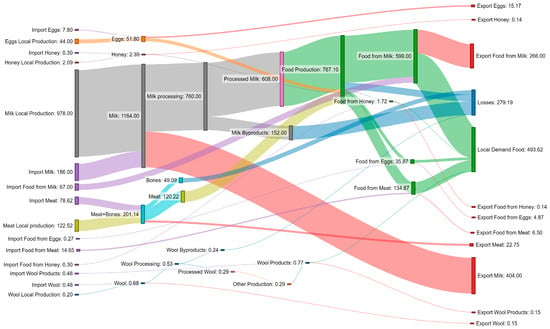
Figure 1.
Sankey diagram for the base year results (2015) in thousand tons (kt).
Even after introducing new technologies, the desired result of the complete use of by-products has not been achieved yet in any scenario because of local market limitations. However, it can be observed that trends calculated by the model show an increase in local and imported commodity volumes in 2023 and 2030 compared to the base year 2015 while having a decrease in total material losses. Although only part of the by-products was used in the production of the new products, their economic contribution over the 7-year period is noticeable. When introducing new technologies, the cumulative added value is calculated to exceed the set goal of a 30% added value increase in bioresources in 2030 by more than two times (62%) in years 2023–2030 in the case where these technologies are introduced starting in 2023 (see Figure 2).
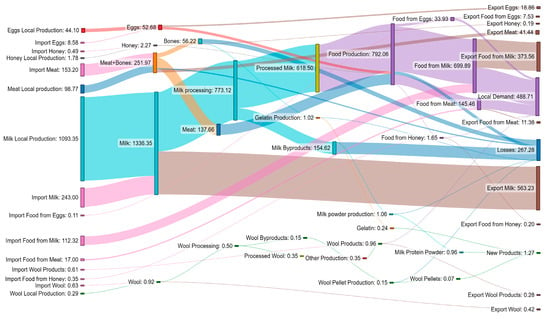
Figure 2.
Sankey diagram for the results of year 2023 in thousand tons (kt).
Similarly, a Sankey diagram for 2030 with the results of the simulation, including data added on new products (gelatine, wool pellets, milk whey protein powder, and eggshell powder), is shown in Figure 3. The graph shows that flows for both domestic milk production and imported milk will increase, which are the largest flows, still followed by imports of imported dairy food and meat production. The by-products generated in the milk processing process are almost constant, which is the main source of by-products, but due to the new products, the total resource loss decreases by 33.9 kt. The final food flows show that the volume of exported milk has increased by 1.6 times compared to 2015, while food produced from milk has increased by almost 1.9 times. Other flows have also grown significantly, for example, exported meat by 2.7 times, exported wool and its products by 3.1 times, and exported eggs and their products by 1.7 times, but these flows are smaller against the overall background in mass units.
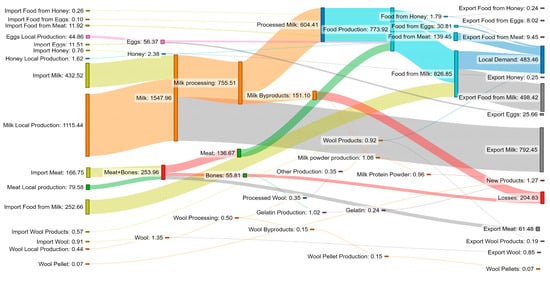
Figure 3.
Sankey diagram for the results in target year (2030) in thousand tons (kt).
Among the new products, the model results show produced milk protein powder, gelatin, and wool pellets (see Figure 4) but no eggshell powder. The production of the new products is influenced by the efficiency and cost of the production processes and the added value per unit because the eggshell powder has a relatively low production efficiency due to the mass ratio and relatively high losses when the powder is produced from a whole egg.
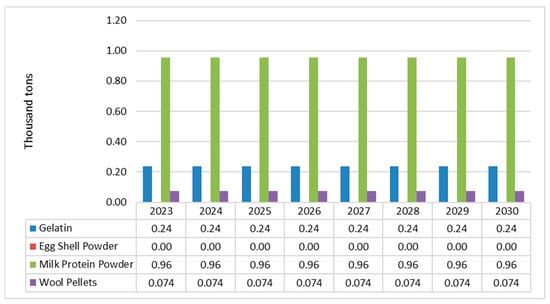
Figure 4.
Amount of new products produced, kt.
The model reaches the limits (e.g., the capacity of resource application, economic viability, and demand limit) of available resources for milk protein powder and gelatin; thus, the same amount is produced every year. Protein powder and gelatin reach the available resource limits immediately in 2023, and, therefore, their production is constant. As for the wool pellets, all of the wool resources available are used to produce wool pellets. The forecasted demand for pellets, on the other hand, is 58.37 thousand tons. The pellets produced are only about 0.1% of this demand value. If forecasted demand values were removed, then all added value would be covered by milk protein powder.
Value added from new products as a share of total value added in different years ranges from 7.6% to 8.2%. On average, the added value is 7.9% per year. This percentage changes as the amount of other products produced changes from year to year, but the amount of new products produced remains the same each year (see Figure 5).
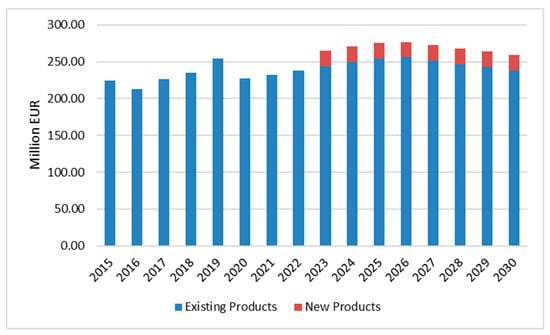
Figure 5.
Total existing and new product added value, EUR million.
Figure 6 shows the added value for newly produced added-value products. In this case, milk protein powder takes up most of the value added, which is probably due to the fact that milk products constitute the largest share of food products and the added value per unit of milk protein powder is larger than that of other products.
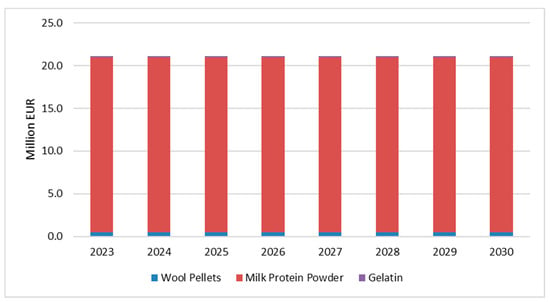
Figure 6.
Added Value Structure for newly produced added-value products.
3. Materials and Methods
3.1. Modeling Approach
The selected modeling approach through TIMES allows for linking energy sector consumption and conversion technologies with other sectors []. The TIMES model parameters consider resource limits and costs, operating and maintenance costs of product production technologies, and the demand for specific products and also allow the definition of new parameters in the model, such as the added value of the product. Simulations of the model allow us to capture both mid- and long-term results. Besides biomass flows, the model allows us to include by-product and waste flow definitions for processes in biorefineries, and, finally, the model is an optimization model that helps to find and select the best scenario for bioeconomy development considering the least expensive solutions for various technologies. The chosen modeling approach applies optimization to discover the most economically feasible solution to reach the determined goal—to achieve a 30% added value in 2030 with the production of new products with a higher added value by introducing new technologies and using residual products as raw materials. For scenario investigation in this research, backcasting is used—it starts with the definition of the preferable future and further works backward to spot the necessary measures to reach the targets.
The TIMES bioeconomy value model (TIMES-BVM) is designed to model bioresource flows and technologies for the development of the animal husbandry sector; however, it can be modeled to research other sub-sectors in agriculture, such as cereal farming, field plant production, greenhouse horticulture, and others. The aim of the model is to help understand how the agricultural sub-sector can contribute to meeting the higher value-added goal for bioresource growth for 2030. The model addresses the development of biorefineries from the perspective of natural limits (the capacity of resource application), economic viability (technology, maintenance, and operation), and socio-economic aspects (increased salaries, etc.).
The model created in the research is used to find the most economically viable scenario for increasing the value of bioresources. It is achieved through an optimization-type simulation, which uses historical data from 2015 to 2019 and a forecast of future industry development trends as well as opportunities to use new bioresource technologies for the production of higher-added-value products starting in 2023.
3.2. Data Analysis and Inventory
The model structure is created based on the general TIMES-BVM structure, including resources (in this case, primary livestock resources such as eggs, meat, milk, wool, and honey), technologies (pre-processing and preparation of raw products; production of food, feed, and other products; and also processing of by-products), product flow (import, export, and domestic production) and demand. Processes used in the structure are divided into primary production, import and export processes, transformation activities like those in biorefineries, and product demand (see Figure 7). These elements are defined based on data from statistical databases, such as the Central Statistics Bureau (CSB) of Latvia, Eurostat and Faostat databases, those from the literature, interviews of companies, and approximations.
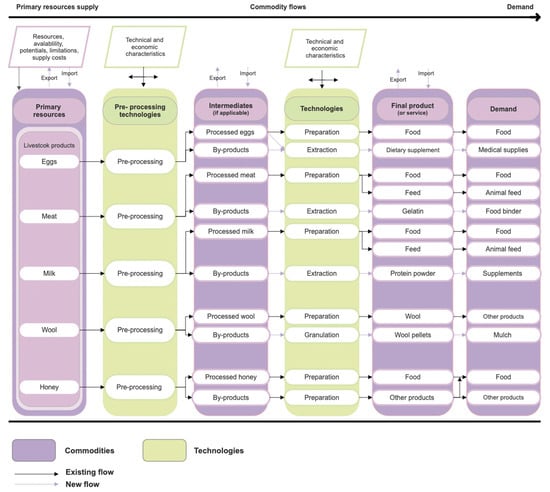
Figure 7.
BVM TIMES Livestock model structure.
The model includes four bioresource stages: primary and processed resources, final product, and demand. Various technological processes are integrated for primary resource supply in terms of local and imported resources, costs, efficiency, capacity, availability, and limitations of processing technologies for primary and secondary resources. Each conversion path in the simulation of the model is calculated through an optimization approach, and the results show the best solution to satisfy the demand at the lowest cost. The results include the technical and economic characteristics of the pathways based on the model inventory. The model output is produced as a quantitative result for biomass flows and new capacity additions for technologies used in the production of products to meet the demand, the overall costs, and the overall added value of the products supplied, shown in Table 1.

Table 1.
TIMES-BVM model input data.
The structure of TIMES-BVM requires the definition of product demand for the selected target year of simulation, and it is carried out by applying a forecast based on regression analysis according to methods introduced in the literature []. Input data for the request of finished products are fixed on prediction based on regression analysis for the years up to 2030. Regression analysis is performed prior to running the model. The demand for the finished product is a dependent variable in regression analysis.
The data input for resource import, export, and domestic production values is based on the extrapolation of statistical trends from 2015 to 2019 with the help of regression analysis. These values have upper and lower boundaries entered into the model in the range of ±10%, except for meat, which has a range of ±25%. These ranges allow tradeoffs among other processes in order to fulfill the demand within the given set of limited capacities of technologies and resources. The selected boundaries allow production to match the demand and the avoidance of model instabilities due to poor statistical data availability and quality. This assumption allows the avoidance of shortages or surpluses that are neither consumed nor exported.
3.2.1. Honey
In the case of honey production in Latvia, the statistics of the honey industry are wildly inaccurate because some honey is legally sold without official accounting and without paying taxes. The approximate amount of honey produced in a certain year is determined by multiplying the average amount of honey produced in one farm by the total number of farms in operation in the given year.
According to CSB statistical data, the amount of honey produced in 2018 was 2000 tons, while according to calculations made in accordance with the method described above, it was 3809 tons, which is almost 2 times higher. For the purposes of the study, the latter amount of 3809 tons was used in the model. Since there is no record of honey consumption in Latvia’s statistical database, it was assumed to be 100%—everything produced is also consumed. It should be considered that honey is not just one final product, and it differs depending on the flower nectar from which it is obtained. Thus, there are differences in both price and demand depending on the type of honey. Regardless of this factor, the price of honey is very stable, and there are no fluctuations in price observed. To increase the value added in the honey production industry, products such as honey, beeswax gums, face creams and soaps, royal jelly (nutritional supplement), propolis, and pollen (natural antibiotics) can be produced but have not been studied in this research further because of insufficient data.
3.2.2. Milk
Dairy farming in Latvia is a traditional and highly developed industry. It is one of the most important sub-sectors of the agricultural sector in Latvia. According to the CS data, the number of dairy cow herds is decreasing annually. In contrast, the milk yield from one cow shows a positive trend. In 2002, the average milk yield from one cow in Latvia was 3.96 tons [], but now, it is already remarkably close to the average European cow productivity, which was 7.5 tons in 2020 []. Despite considerable progress, the Central Union of Dairy Farmers of Latvia (LPCS) claims that it is no longer profitable to produce dairy products in Latvia [].
According to the survey of local dairy farmers, it can be concluded that for several years in Latvia, there has been a tendency to import the milk needed for dairy processing at lower prices instead of using local milk. The analyzed statistical data and forecasts based on extrapolations used as the data inputs for the model (see Figure 8) show a steady trend in domestic milk production. At the same time, an upward trend in import and export, while a downward trend is visible in domestic milk food (processed dairy products) production, which provides products with higher added value, and an upward trend is observed in exported and imported milk food products.
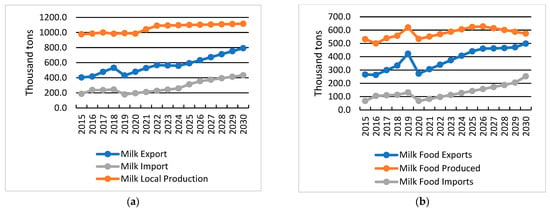
Figure 8.
(a) Milk import, export, and local production; (b) Milk food import, export, and local production.
Potential products could be protein powder, agricultural fertilizer, polymers, alcohol, lactic acid concentrate, animal feed, etc. In order for each farm to find the most efficient and best solution, it is necessary to understand not only the seriousness of the situation in the development of future scenarios but also clarify the expertise required, how to assess it, and information on available public support.
3.2.3. Eggs
In the egg market in Latvia, the number of eggs laid is constantly increasing, and more is produced than is needed for the local market, so a large part is exported. The extrapolated statistical data presented in Figure 9 are used as input for the model. In Figure 9b, the forecast shows that a significant drop in domestically produced egg produce (processed products) can be expected, while the import of egg products remains constant.
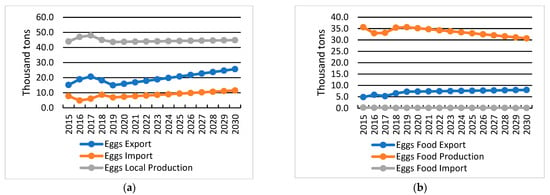
Figure 9.
(a) Egg import, export, and local production; (b) Egg Food import, export, and local production.
As egg whites, yolks, and eggshells contain many valuable substances, these could be used to produce health-promoting products. Chicken eggshells consist of 95% calcium carbonate, an excellent filler in composites, which is easy to use in production due to its low specific density []. Since calcium builds and ensures healthy bones, egg powder, which contains substances such as magnesium, fluoride, and other minerals, can also serve as an effective calcium supplement []. Therefore, it is essential to explore the possibilities of producing eggs for primary consumption, export, and products with higher added value, which could benefit the development of local egg production.
3.2.4. Meat
Poultry plays an important role in the meat industry, with chicken meat accounting for the largest share. The extrapolated statistical data shown in Figure 10 are used as input for the meat section in the model. The statistical data and forecasts made show that the total demand for meat food (processed meat) in Latvia will decrease in the future (see Figure 10b). There is a significant decline in local meat (raw) production from 2019 to 2023. Although the upward trend in meat production resumes in 2024, it is slow and stagnant compared to the huge jump in imported meat volumes that can be observed already from 2020. The production of meat products (see Figure 10b) for the local market will remain almost unchanged in 2030, while the export, import, and production of meat products for processing into products with a higher added value will consequently decrease.
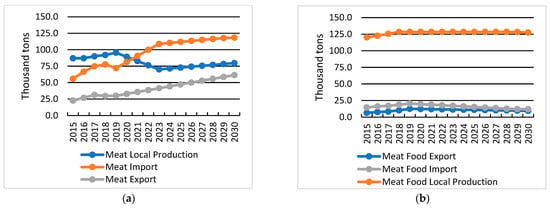
Figure 10.
(a) Meat Import, Export, and Local Production; (b) Meat Food import, export, and local production.
Potential products with higher added value considered in the model are biogas (for example, turkey tails, etc., where the fat content is particularly high), animal feed (bones, dog treats, etc.), gelatin, lime, broth, bone paste and powder, various extracts, protein of animal origin, and collagen.
3.2.5. Wool
The input data for wool (raw) used for the model are shown in Figure 11. According to the statistical data analysis and trend extrapolation, exported wool is rising rapidly, while the amount of exported wool products with higher added value is falling rapidly. Although wool imports are growing rapidly, the demand for wool product imports is forecasted to decline. Domestic wool production, on the other hand, is slowly growing, while production volumes of domestic wool products remain constant.
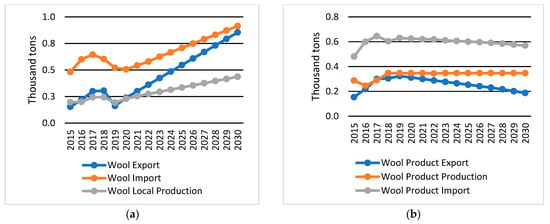
Figure 11.
(a) Wool import, export, and local production; (b) Wool Product import, export, and local production.
According to the current situation, wool export will continue to decrease, and even in local wool processing, no improvements are expected. Wool production is related to the production of sheep meat and the number of sheep. According to the statistics, there is a decreasing trend in the number of sheep in Latvia since 2017. The trend of local wool production is directly dependent on other influencing factors, such as the development of the meat market.
3.2.6. New Technologies for Higher-Added-Value Products
The new technologies to produce higher-added-value products included in the model structure are:
- (1)
- Dietary supplement production from processed eggshells;
- (2)
- Gelatin production from meat-processing by-products;
- (3)
- Protein powder production from milk-processing by-products;
- (4)
- Production of wool pellets from wool-processing by-products;
- (5)
- Production of honey-derived products from honey by-products.
The limit for the availability of new technologies in the model is set to 2023, signifying the current possible implementation of these technologies. The production amounts are limited by the available by-products and waste products from existing processes. Therefore, the production of new products with higher added value depends on the demand and thus also the local production of the conventional products. The demand was defined based on the historical average market data for these segments []:
- Calcium carbonate;
- Gelatin and its derivatives (excluding casein glues, bone glues, and isinglass);
- Protein concentrates and flavored or colored sugar syrups;
- Pellets and briquettes of pressed and agglomerated wood and of vegetable waste and scraps.
The added value of the item is recognized as factor costs and is established as the gross earnings of biorefineries (salaries included) for operating activities. It is estimated based on the official CSB available data on the market-added value and produced volume of goods [].
3.2.7. Other Assumptions and Limitations
Other factors limiting the use of by-products within the model were assumptions about technologies—process efficiencies; resource and product prices and costs; and upper and lower limits on the import, export, and local production of raw resources and final products—as they influence the commodity balance and thus indirectly influence the need for resource processing, resulting in different amounts of by-products and, consequently, different amounts of new products.
While the energy efficiency of the European Union’s agriculture has remained relatively constant over the years, the energy efficiency indicators of Latvia’s agricultural sector show a downward trend from 2010 to 2017. The total consumption of energy resources of the agricultural sector has increased year by year since 2010, while the turnover of manufactured products has not been able to generate a sufficiently competitive economic contribution to compensate for the increase in energy consumption. To increase energy efficiency, it is necessary to implement energy management, which is the intelligent and efficient use of energy to maximize profits while reducing costs []. Moreover, energy management is related to the economic and environmental aspects to eliminate the inefficient and reckless use of resources, which in turn causes global warming []. The data used in the model and the model itself do not consider any potential benefits that could result from the application of energy efficiency measures in the agricultural sector and that could derive from the implementation of energy policy goals. Also, the impact of breeding and genetics, as well as welfare and feeding, on the productivity of production is not considered in this study.
3.3. Validation of the Results
Mass balance validation is used as a crucial element in the TIMES model to guarantee the robustness of the findings. Potential discrepancies in the representation of commodity and resource flows can be found and corrected using mass balancing. Mass balance calculation for the obtained results ensures uniformity and precision of the results obtained. The mass balance calculation is adopted from the EN 16785-2 standard “Bio-based products—Bio-based content—Part 2: Determination of the biobased content using the material balance method” [] as shown in Equation (1):
where:
- Min,i is the mass, expressed in kilograms of the input commodity i entering the production process under consideration;
- Mlo,j is the mass, expressed in kilograms of the loss i in the production process under consideration;
- Mt,out is the total mass of the product, expressed in kilograms, leaving the production process under consideration.
When discrepancies in mass balance are found, additional research is conducted to determine the precise causes and probable sources of errors in the model assumptions. These could be typographical errors in data entry, insufficiency of data sources, or unrealistic modeling assumptions. Once the differences are identified, the necessary corrections can be made to guarantee a more accurate depiction of the model simulation outputs.
4. Conclusions
The study presents a novel model that helps to investigate the application of new technologies in the agriculture sector and evaluate their contribution to the agriculture sector in terms of the production of new competitive products and the development of biorefineries that have a significant impact on both agriculture and other sectors overall resource efficiency. The model shows that the production of local resources with a higher added value would bring a more outstanding contribution to the local economy. In terms of mass, however, the desired result of the maximum use of by-products was not achieved in any scenario. When introducing the new technologies starting in 2023, the local bioeconomy benefits strongly by producing higher-added-value products.
In this study, the evaluation of aspects related to biorefinery implementation is performed with the developed model in relation to the national bioeconomy goal set for a 30% increase in the added value of bioresources by 2030. The new technologies introduced in the model that create higher added value from bioresources obtained in animal husbandry are the production of protein powder, gelatin, and wool pellets. The new technologies in the model are available starting in 2023 and are used in the production of added-value products. The cumulative added value produced from 2023 to 2030 is about 62% above the added value produced by currently used technologies. However, the maximum use of bioresources has not been achieved due to assumptions limiting the production of new products in line with the market size for these products. The production of milk protein powder and gelatin reached the set market size limit. The production of wool pellets reached the maximum of what was possible given the amount of wool processing by-products. The remaining eggshell powder amount could potentially be decreased with higher eggshell powder production efficiency or higher added value for eggshell powder.
The model makes it possible to evaluate aspects related to an increase in added value empirically with a time reference in order to find an optimal scenario for the development of the agricultural sector. This can be useful for making agricultural stakeholders aware of the development of biorefineries and their positive impact on the local economy. The obtained optimal scenario can be used in national policy planning, as it clarifies which technologies are worth investing in and what agriculture residuals have the most potential to be used to produce higher-added-value products. Further research with statistical data from other sources and the introduction of more new technologies can be applied in the TIMES bioeconomy value model (TIMES-BVM) for defining more possible scenarios for the development of biorefining and development of suggestions for bioeconomy policy planning.
Author Contributions
Conceptualization, D.B.; Methodology, K.B., M.F. and P.A.; Validation, K.B. and M.F.; Investigation, K.B.; Writing—original draft, K.B.; Writing—review and editing, M.F.; Visualization, P.A.; Supervision, D.B. All authors have read and agreed to the published version of the manuscript.
Funding
This research was funded by the European Social Fund within project no 8.2.2.0/20/I/008 “Strengthening of PhD students and academic personnel of Riga Technical University and BA School of Business and Finance in the strategic fields of specialization” of the Specific Objective 8.2.2 “To Strengthen Academic Staff of Higher Education Institutions in Strategic Specialization Areas” of the operational program “Growth and Employment”.
Data Availability Statement
Not applicable.
Conflicts of Interest
The authors declare no conflict of interest.
References
- UN Department of Economic and Social Affairs. World Population Prospects 2022: Summary of Results. Available online: https://www.un.org/development/desa/pd/content/World-Population-Prospects-2022 (accessed on 27 February 2023).
- Bezrucko, T.; Lauka, D.; Laktuka, K.; Sniega, L.; Vamza, I.; Dzalbs, A.; Terjanika, V.; Blumberga, D. Bioeconomy towards green deal. Case study of citric acid production through fuzzy cognitive maps. Environ. Clim. Technol. 2022, 26, 684–696. [Google Scholar] [CrossRef]
- Aguilar, A.; Twardowski, T. Bioeconomy in a changing world. EFB Bioeconomy J. 2022, 2, 100041. [Google Scholar] [CrossRef]
- How the EU Bioeconomy Contributes to the European Green Deal. ePURE. Available online: https://www.epure.org/news/how-the-eu-bioeconomy-contributes-to-the-european-green-deal/ (accessed on 31 October 2022).
- Camia, A.; Robert, N.; Jonsson, K.; Pilli, R.; Garcia Condado, S.; Lopez Lozano, R.; Van Der Velde, M.; Ronzon, T.; Gurria Albusac, P.; M’barek, R.; et al. Biomass Production, Supply, Uses and Flows in the European Union: First Results from an Integrated Assessment; Publications Office of the European Union: Luxembourg, 2018. [CrossRef]
- Bell, J.; Paula, L.; Dodd, T.; Németh, S.; Nanou, C.; Mega, V.; Campos, P. EU ambition to build the world’s leading bioeconomy—Uncertain times demand innovative and sustainable solutions. N. Biotechnol. 2018, 40, 25–30. [Google Scholar] [CrossRef]
- Singh, R.; Paritosh, K.; Pareek, N.; Vivekanand, V. Integrated system of anaerobic digestion and pyrolysis for valorization of agricultural and food waste towards circular bioeconomy: Review. Bioresour. Technol. 2022, 360, 127596. [Google Scholar] [CrossRef] [PubMed]
- European Commission. Bioeconomy Strategy. Available online: https://research-and-innovation.ec.europa.eu/research-area/environment/bioeconomy/bioeconomy-strategy_en (accessed on 27 February 2023).
- Zihare, L.; Indzere, Z.; Patel, N.; Feofilovs, M.; Blumberga, D. Bioresource Value Model. Case of Fisheries. Environ. Clim. Technol. 2021, 25, 1179–1192. [Google Scholar] [CrossRef]
- Summary of the Greenhouse Gas Inventory Submitted in 2020. Rīga. 2020. Available online: https://www.meteo.lv/fs/CKFinderJava/userfiles/files/Vide/Klimats/Majas_lapai_LVGMC_2020_seginvkopsavilkums.pdf (accessed on 30 November 2020).
- EEA. “ENVIRONMENT AND AGRICULTURE” Project of the “National Climate Policy” Program. Available online: https://estudijas.llu.lv/pluginfile.php/129183/mod_resource/content/1/VIDE_LAUKSAIMNIECIBA.pdf (accessed on 14 May 2018).
- Kour, D.; Rana, K.L.; Yadav, A.N.; Yadav, N.; Kumar, M.; Kumar, V.; Vyas, P.; Dhaliwal, H.S.; Saxena, A.K. Microbial biofertilizers: Bioresources and eco-friendly technologies for agricultural and environmental sustainability. Biocatal. Agric. Biotechnol. 2020, 23, 101487. [Google Scholar] [CrossRef]
- Lammerts Van Bueren, E.T.; Verhoog, H.; Tiemens-Hulscher, M.; Struik, P.C.; Haring, M.A. Organic agriculture requires process rather than product evaluation of novel breeding techniques. NJAS Wagening. J. Life Sci. 2007, 54, 401–412. [Google Scholar] [CrossRef]
- Yu, L.; Qin, H.; Xiang, P.A. Incentive mechanism of different agricultural models to agricultural technology information management system, Sustain. Sustain. Comput. Inform. Syst. 2020, 28, 100423. [Google Scholar] [CrossRef]
- Welfle, D.A.; Chingaira, S.; Kassenov, A. Decarbonising Kenya’s domestic & industry Sectors through bioenergy: An assessment of biomass resource potential & GHG performances. Biomass Bioenergy 2020, 142, 105757. [Google Scholar] [CrossRef]
- Ersoy, E.; Ugurlu, A. The potential of Turkey’s province-based livestock sector to mitigate GHG emissions through biogas production. J. Environ. Manag. 2020, 255, 109858. [Google Scholar] [CrossRef]
- O’Callaghan, K. Technologies for the utilisation of biogenic waste in the bioeconomy. Food Chem. 2016, 198, 2–11. [Google Scholar] [CrossRef] [PubMed]
- Carioca, J.O.B.; Leal, M.R.L.V. Ethanol Production from Sugar-Based Feedstocks. In Comprehensive Biotechnology, 2nd ed.; Elsevier: Amsterdam, The Netherlands, 2011; Volume 3, pp. 27–35. [Google Scholar] [CrossRef]
- Rutkovska, A. Agriculture Is a Complex Industry with a Big “BUT”|Macroeconomics. 2022. Available online: https://www.makroekonomika.lv/lauksaimnieciba-ir-sarezgita-nozare-ar-lielo-bet#1-lauk (accessed on 16 March 2023).
- Mercure, J.F.; Pollitt, H.; Edwards, N.R.; Holden, P.B.; Chewpreecha, U.; Salas, P.; Lam, A.; Knobloch, F.; Vinuales, J.E. Environmental impact assessment for climate change policy with the simulation-based integrated assessment model E3ME-FTT-GENIE. Energy Strateg. Rev. 2018, 20, 195–208. [Google Scholar] [CrossRef]
- Barker, T. The effects on competitiveness of coordinated versus unilateral fiscal policies reducing GHG emissions in the EU: An assessment of a 10% reduction by 2010 using the E3ME model. Energy Policy 1998, 26, 1083–1098. [Google Scholar] [CrossRef]
- Novero, A.U.; Pasaporte, M.S.; Aurelio, R.M., Jr.; Madanguit, C.J.G.; Tinoy, M.R.M.; Luayon, M.S.; Oñez, J.P.L.; Daquiado, E.G.B.; Diez, J.M.A.; Ordaneza, J.E.; et al. The use of light detection and ranging (LiDAR) technology and GIS in the assessment and mapping of bioresources in Davao Region, Mindanao Island, Philippines. Remote Sens. Appl. Soc. Environ. 2019, 13, 1–11. [Google Scholar] [CrossRef]
- Coppens, L.; Gargiulo, M.; Orsini, M.; Arnould, N. Achieving −55% GHG emissions in 2030 in Wallonia, Belgium: Insights from the TIMES-Wal energy system model. Energy Policy 2022, 164, 112871. [Google Scholar] [CrossRef]
- Aryanpur, V.; Balyk, O.; Daly, H.; Gallachóir, B.Ó.; Glynn, J. Decarbonisation of passenger light-duty vehicles using spatially resolved TIMES-Ireland Model. Appl. Energy 2022, 316, 119078. [Google Scholar] [CrossRef]
- Di Leo, S.; Caramuta, P.; Curci, P.; Cosmi, C. Regression analysis for energy demand projection: An application to TIMES-Basilicata and TIMES-Italy energy models. Energy 2020, 196, 117058. [Google Scholar] [CrossRef]
- Reyseliani, N.; Hidayatno, A.; Purwanto, W.W. Implication of the Paris agreement target on Indonesia electricity sector transition to 2050 using TIMES model. Energy Policy 2022, 169, 113184. [Google Scholar] [CrossRef]
- Balyk, O.; Andersen, K.S.; Dockweiler, S.; Gargiulo, M.; Karlsson, K.; Naeraa, R.; PETROVIć, S.; Tattini, J.; Termansen, L.B.; Venturini, G. TIMES-DK: Technology-rich multi-sectoral optimisation model of the Danish energy system. Energy Strategy Rev. 2019, 23, 13–22. [Google Scholar] [CrossRef]
- McDowall, W.; Rodriguez, B.S.; Usubiaga, A.; Fernández, J.A. Is the optimal decarbonization pathway influenced by indirect emissions? Incorporating indirect life-cycle carbon dioxide emissions into a European TIMES model. J. Clean. Prod. 2018, 170, 260–268. [Google Scholar] [CrossRef]
- Daly, H.E.; Ramea, K.; Chiodi, A.; Yeh, S.; Gargiulo, M.; Gallachóir, B.Ó. Incorporating travel behaviour and travel time into TIMES energy system models. Appl. Energy 2014, 135, 429–439. [Google Scholar] [CrossRef]
- Pavičević, M.; Mangipinto, A.; Nijs, W.; Lombardi, F.; Kavvadias, K.; Navarro, J.P.J.; Colombo, E.; Quoilin, S. The potential of sector coupling in future European energy systems: Soft linking between the Dispa-SET and JRC-EU-TIMES models. Appl. Energy 2020, 267, 115100. [Google Scholar] [CrossRef]
- Statistics. Eurostat. Sold Production, Exports and Imports. Available online: https://ec.europa.eu/eurostat/databrowser/bookmark/46730036-dfb9-4ee7-9c35-887145e13314?lang=en (accessed on 14 June 2023).
- Statistics. Jobs and Wealth in the European Union Bioeconomy (Biomass PRODUCING and Converting Sectors). Available online: https://datam.jrc.ec.europa.eu/datam/mashup/BIOECONOMICS/index.html (accessed on 14 June 2023).
- Statistics. Average Milk Yield from One Cow, kg—Time Period. PxWeb. Available online: https://data.stat.gov.lv/pxweb/lv/OSP_PUB/START__NOZ__LA__LAL/LAL070/table/tableViewLayout1/ (accessed on 7 October 2022).
- Statistics. Milk and Milk Product Statistics. Statistics Explained. Available online: https://ec.europa.eu/eurostat/statistics-explained/index.php?title=Milk_and_milk_product_statistics#Milk_production (accessed on 7 October 2022).
- Escribano, M.; Horrillo, A.; Mesías, F.J. Greenhouse gas emissions and carbon sequestration in organic dehesa livestock farms. Does technical-economic management matters? J. Clean. Prod. 2022, 372, 133779. [Google Scholar] [CrossRef]
- Rodríguez, C.M.; Rengifo Rodas, C.F.; Corrales Muñoz, J.C.; Casas, A.F. A multi-criteria approach for comparison of environmental assessment methods in the analysis of the energy efficiency in agricultural production systems. J. Clean. Prod. 2019, 228, 1464–1471. [Google Scholar] [CrossRef]
- Li, N.; Jiang, Y.; Mu, H.; Yu, Z. Efficiency evaluation and improvement potential for the Chinese agricultural sector at the provincial level based on data envelopment analysis (DEA). Energy 2018, 164, 1145–1160. [Google Scholar] [CrossRef]
- Channabasavanna, S.G.; Gowda, T.V.; Manjunatha, L.H.; Sharvani Shekar, P.R.; Chandan Kumar, S.M. Development and testing of glass/kenaf inter-ply hybrid polymer composites with egg shell powder as filler. Mater. Today Proc. 2021, 45, 270–276. [Google Scholar] [CrossRef]
- Waheed, M.; Butt, M.S.; Shehzad, A.; Adzahan, N.M.; Shabbir, M.A.; Rasul Suleria, H.A.; Aadil, R.M. Eggshell calcium: A cheap alternative to expensive supplements. Trends Food Sci. Technol. 2019, 91, 219–230. [Google Scholar] [CrossRef]
- CSM EN 16785-2; Bio-Based Products—Bio-Based Content—Part 2: Determination of the Biobased Content Using the Material Balance Method. iTeh Standards: Etobicoke, ON, Canada, 2018.
Disclaimer/Publisher’s Note: The statements, opinions and data contained in all publications are solely those of the individual author(s) and contributor(s) and not of MDPI and/or the editor(s). MDPI and/or the editor(s) disclaim responsibility for any injury to people or property resulting from any ideas, methods, instructions or products referred to in the content. |
© 2023 by the authors. Licensee MDPI, Basel, Switzerland. This article is an open access article distributed under the terms and conditions of the Creative Commons Attribution (CC BY) license (https://creativecommons.org/licenses/by/4.0/).